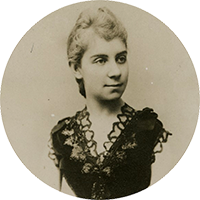Think
"To them..."
WOMEN AT WAR: SOFIA CASANOVA AND EDITH WHARTON
Interviewing Trotski and Franco, surviving two wars, raising money for the victims of the conflict, healing friends and enemies, driving through the trenches interviewing soldiers and much more. Onésimo Díaz shares with us some notes from his new book Mujeres Protagonistas del siglo XX. Forget ballerinas and princesses: "I want to be a writer", "I am a war correspondent".
In hard times, heroism flourishes. During the last century, marked by great wars and conflicts, among the many sparks of submission and bravery, we would like to highlight two exceptional cases, hidden from the majority. They are two women, magnanimous, kind and invisible.
 A woman ahead of her time was the Galician writer Sofia Casanova (1865-1958), the first spanish war correspondent. This writer and journalist married a Polish philosopher, survived the two world wars in Poland, and as a correspondent for the Polish newspaper ABC interviewed Trotsky and Franco himself.. We have found his interview with the Russian revolutionary on periodicals collection of the ABC, Click here here to see it (periodicals collection of the ABC, issue March 2, 1918, pp. 3-4)
A woman ahead of her time was the Galician writer Sofia Casanova (1865-1958), the first spanish war correspondent. This writer and journalist married a Polish philosopher, survived the two world wars in Poland, and as a correspondent for the Polish newspaper ABC interviewed Trotsky and Franco himself.. We have found his interview with the Russian revolutionary on periodicals collection of the ABC, Click here here to see it (periodicals collection of the ABC, issue March 2, 1918, pp. 3-4)
She worked as a nurse in a Red Cross hospital on the Eastern Front during the First World War (1914-1918). First in Poland and then in Russia, she sent articles of what she saw to the ABC newspaper. She also reported to her newspaper about the Russian Revolution and the assassination of the royal family: The long road of bitterness, which had been more than a year since her arrest in Zarskoie-Sielo and the abdication of Nicholas II, was about to end (Casanova 2007: 227-229).
A little known fact is that she was nominated for the award Nobel Prize in Literature.
 Another pioneering and avant-garde woman was the American writer Edith Wharton (1862-1937), one of the first female war correspondents in history. She was at her residency program in Paris when World War I broke out. She had left behind her early years with her wealthy family in New York, her training years in the hands of governesses. In 1914 he was 52 years old, and enjoyed prestige as a novelist.
Another pioneering and avant-garde woman was the American writer Edith Wharton (1862-1937), one of the first female war correspondents in history. She was at her residency program in Paris when World War I broke out. She had left behind her early years with her wealthy family in New York, her training years in the hands of governesses. In 1914 he was 52 years old, and enjoyed prestige as a novelist.
From the outset, Wharton identified with the French cause, raising money for mobile hospitals. He also organised financial aid for Belgian refugees in Paris through a unique initiative, which consisted of collecting writings, paintings and scores by prestigious artists for The Book of the Hom eless (1916). He also raised funds to open and support numerous orphanages. For this work, the French government awarded him the Legion of Honour.
Wharton travelled along the front in her own car. Her prestige as a writer and her privileged social position enabled her to obtain driving licences without any problems. Her war experience was published in a series of articles in Scribner's Magazine, which were also published in the book Combatant France. In these stories, women featured as prominently as men. "The Spirit of France" was the title of the chapter on the courage of the soldiers at the front and the efforts of the women in the work posts left by the men.
That same evening we went into a restaurant on rue Royale,
and sat by one of the open windows, at street level.
From there we saw new and strange groups of people parading before our eyes.
groups of people. We could see how, in the blink of an eye, a mobilisation was underway,
a mobilisation was underway. It was like a tremendous interruption
in the normal flow of traffic; like the sudden bursting of a dam.
The street was overrun by a torrent of people who were gliding past us towards the various
thevarious railway stations.
(Wharton, Combatant France, 2009, 29-30)
Wharton - like Casanova - belonged to that group of avant-garde women of the early 20th century. In 1923, Wharton received the doctorate honoris causa from Yale University, and three years later she became a member of the American Academy of Arts and Letters.
Here you can find one of Edith's numerous articles in Scribner's Magazine, called "The French - as seen by an American". (Vol. 62, No. 6, 1918-04-01) (The Modernist Journals Project (searchable database). Brown and Tulsa Universities, ongoing. www.modjourn.org), and also to file the beautiful magazine covers of the period of The Great Gatsby. Enjoy!

|
Apart from Women protagonists of the 20th century (highly recommended), here are a couple of books for those who want to know more:
-
Casanova, Sofia, In the Court of the Tsars. Del principio y del fin de un imperio, Astorga, Akrón, 2007 [original edition 1924].
-
Ochoa, Pedro, "Sofía Casanova, en tránsito (1914-1918)", in Elena Hernández Sandoica (ed.), Política y escritura de mujeres, Madrid, Abada, 2012, pp. 133- 170.
-
Wharton, Edith, Francia combatiente (De Dunkerque a Belfort), Madrid, Impedimenta, 2009 [ed. or. 1915].
- La edad de la inocencia, Barcelona, Tusquets, 1995 [ed. or. 1920].
-, Una mirada atrás. Autobiografía, Barcelona, Ediciones B, 1994 [ed. or. 1934].






